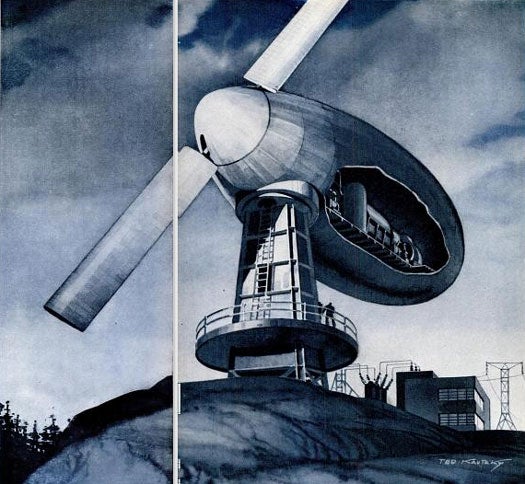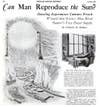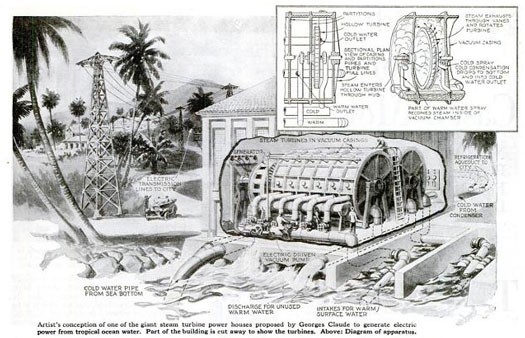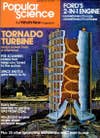Although the issues of climate change and crude oil have received plenty of media coverage over the past decade, scientists have been working for over a century to develop technology capable of replacing conventional fuels with renewable energy.
You could even argue that society has attempted to harness renewable energy since ancient times. Over the past 138 years, Popular Science has seen engineers adapt Dutch windmills into wind turbines, water mills into commercial tidal power facilities, and Roman hot spring-powered underfloor heating systems into geothermal electric power plants.
Going by the illustrations in our archives, however, most early prototypes of those facilities only vaguely resemble today’s wind farms and solar power plants.
There were plenty of things engineers got wrong, of course: for instance, windmills atop the Empire State Building would not meet Manhattan’s power demands, and marine kelp farms would not immediately be recognized as a profitable source of clean fuel. But if there’s one thing everyone did right, it was acknowledging that the transition from conventional fuels to renewable energy would require an extraordinary amount of vision and risk-taking. Experimental projects would be expensive — the Putnam-Smith wind turbine, for example, cost its manufacturer more than US$1.25 million dollars, and the structure was dismantled after operating for only four years.
Despite the setbacks, engineers have only developed more efficient ways to harness our natural resources. The Putnam-Smith wind turbine might have closed, but just last month, the world’s largest offshore wind farm opened in Great Britain.
Renewable energy technology still has a ways to go, so in the meantime, click through our gallery to see where it’s already been.
Artificial Sun: October 1925
Long before people began debating whether conventional fission power counted as a form of sustainable energy, scientists eagerly anticipated the abundance of usable energy the process would generate once they achieved it. From his study of cathode rays and particle theory, French physicist and future Nobel prize winner Jean Baptiste Perrin grew interested in crafting a machine that would use atomic disintegration to deliver 10 million volts of direct current. Theoretically, his “sun-producing plant of the future” would produce a permanent energy source that would replace coal and oil. We speculated that atomic disintegration, once achieved, would usher in an era of cheap power, “of power concentrated into such a small space that the contests of a medicine vial would drive the airship Los Angeles over the North Pole and back to her hangar.”
Giant Steam Turbine: October 1928
By the late 1920’s, scientists had begun considering the ocean as a viable power source. French engineer Georges Claude, inventor of the neon lamp, was also the first person to build prototype ocean thermal energy conversion facilities. Like today’s machines, his turbines worked by drawing power from temperature differences between deep and shallow waters. In 1928, he reportedly generated forty kilowatts of electric power from the Meuse River’s natural heat. Following his success at that location, Claude proposed building larger stations and commercial plants in tropical waters. The image featured here shows an artist’s conception for Claude’s giant steam turbine, which would not only supply electricity, but would pipe cold water to surrounding areas. Between 1930 and 1935, Claude constructed two plants in Cuba and Brazil, but both were destroyed by storms before they could be used profitably.
Solar Power Plant: November 1929
Although American physicist Robert H. Goddard, who built the world’s first liquid-propellant rocket, is well-known for his contributions to spaceflight, he also patented a motor that could convert sunlight into usable energy. A large aluminum mirror would reflect the sun and focus its heat on a steam-generating unit.
Skyscraper Windmills: June 1932
For decades, we’ve been trying to figure out the most efficient way to extract energy from high winds. Hermann Honnef, a German structural engineer, proposed using giant windmills atop skyscrapers to provide cities with cheap electric power. Using the Empire State Building as an example, Honnef designed a two-wheeled, 12-story tower equipped with electric dynamos in the hubs to generate a current. Wheels would have a diameter spanning two city blocks and would rotate seven and a half times per minute, or at 142 miles per hour. According to his calculations, a three-wheeled skyscraper windmill could provide electricity to a city with a population of 100,000.
Polar Windmills: March 1936
Cambridge University professor Frank Debenham, who co-founded the Scott Polar Research Institute, touted the North and South Poles as ideal locations for wind farms. Operators would run switchboards within each turbine, while tunnels leading to underground generators would convert the wind energy into electrical power. Debenham speculated that with the vast supply of electricity available, people would eventually migrate to the Polar areas for business or to take advantage of the mineral deposits hidden beneath the frozen soil.
Smith-Putnam Wind Turbine: July 1941
In the late 1930’s, engineer Palmer Putman teamed up with General Electric and the Central Vermont Public Service Corporation to develop an experimental turbine. The S. Morgan Smith Company agreed to manufacture the machine, which ended up becoming the world’s first megawatt-sized wind turbine. While the final version of the Smith-Putnam wind turbine looked nothing like the one pictured left, artists couldn’t help drawing inspiration from the war to imagine this torpedo-like structure towering over rustic Vermont. The actual turbine used a synchronous generator provided by General Electric, which produced 2,400 volts per 60 cycles. After its construction in late 1941, the Smith Putnam wind turbine ran for 1100 hours before one of its blades failed. The turbine was dismantled in 1946 after the S. Morgan Smith company decided that the project with not profitable.
Tidal Power: June 1965
For the past few decades, engineers have struggled to develop technology that can efficiently convert tidal power in electricity. After 40 years of planning, the Rance Tidal Power Station, located in France, opened in 1966 as the world’s first tidal power facility. We reported that the Rance power plant would conquer the typical issues, such as tides’ reliance on lunar rhythms, by creating artificial tides running at 24-hour intervals. This required creating two dams and draining the are around the power station. Today, the Rance plant generates 240 megawatts from its 24 turbines, thus satisfying 0.012 percent of power needs in France. Read the full story in “Tides to Drive Mammoth Power Plant”
Sea Water Energy: March 1971
Building a tidal power plant is often easier said than done. Dr. O.A. Roels and Robert Gerard, researchers at Columbia Univesity’s Lamont-Doherty Geological Observatory, devised a machine that would use warm wind and water to heat a boiler filled with fluorocarbon refrigerant, which boils at around room temperature. The vapor rising from the refrigerant would turn the turbine generator, while cold water pumped from below 2,500 feet would turn the steam back into a liquid. The process would generate enough power to service a small community. Although Roels and Gerard wanted to build their plant off the coast of St. Croix, the project never quite moved beyond the planning stage.
Geothermal Energy: November 1971
The Earth may contain abundant geothermal resources, but the process of obtaining them and converting them into electricity is challenging and expensive. In the early 1970’s, scientists studied hot water and hot dry-rock deposits as sources of geothermal power. Unfortunately, the high salt concentration of many reservoirs can easily corrode machinery, rendering it useless. We talked to researchers at the Lawrence Livermore Laboratory about a possible method for producing electricity from even the most concentrated brines. A mechanism called the “total-flow impulse turbine” would spray a mixture of brine and vapor against the turbine vanes to power the generator.
Marine Farms: July 1975
When it comes to sustainable energy, the ocean isn’t just a source of tidal power. According to Dr. Richard Bogan, from the National Science Foundation, the sea could also use giant kelp farms to convert energy from solar photons into clean fuel. Of course, there were a couple of problems: first, the ocean is so deep that kelp can’t grow all the way from the bottom to the top, and secondly, an open ocean kelp farms needs to float on the ocean’s surface to absorb solar photons, but that surface is largely devoid of nutrients. Dr. Harold Wllcox, from the Naval Undersea Center in San Diego, proposed anchoring the kelp onto a nutrient-distributing raft. A wave-actuated pump would also transport nutrient-rich cold water to the plants, which would ideally produce methane and petroleum-like chemicals.
Tornado Turbine: January 1977
Remember Hermann Honnef’s skyscraper windmills? In 1977, James Yen, a fluid-dynamics engineer at Grumman Aerospace Corp., began researching turbine towers located in the heart of major metropolises. Theoretically, his design would convert regular winds into mini tornadoes capable of generating electricity. Here’s how it would work: incoming wind would enter the turbine through adjustable vertical vanes. As the wind spirals inward, its velocity increases, creating a low-pressure vortex. Meanwhile, a turbine within the tower would would move air arriving through additional inlets at the tower’s base. The pressure difference between the air at the tower’s bottom and in the vortex created at its top would allow the turbine to generate electricity.











